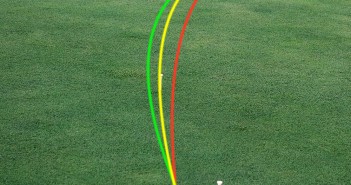This is a great game for improving your putting touch in the 10- to 30-foot (3-9m) range – a range where you really need to give yourself the best possible chance of making a few if you are to shoot low scores, and where at worst you should be leaving yourself a simple tap-in.
Even the world’s best putters will make less than one-third of putts from this range, only about 10% from 20’, but using this game you’ll quickly get better at matching the speed of a putt to its line in order to give yourself the best chance of sinking them, or at worst knocking them very close.
How to Play
To play the Line and Length game, you will need a phony hole (see Figure 1). You can make a phony hole by cutting a circular piece of card, 4.25” (108mm) in diameter. We use the template that you can download here, print it onto thin card, laminate the card, and then cut out the marked circles.
These phony holes are very useful for practising your putting, pitching and chipping, and are used extensively in our drills. We recommend that you create 6 of them and keep them in your golf bag.
Playing the game:
- Choose a part of the practice green that is on a gentle slope, so that you can play putts that break about 36 inches from 27 feet (8.2m), and at least 12 inches from 9 feet.
- Place a phony hole (see above) at one end of the chosen area, such that putts played to this “hole” will break from left to right.
- Mark 3 points on the green with tees, at 9, 18 and 27 feet (2.7, 5.5 and 8.2m) from the hole.
- Stagger the points so that you won’t have to roll the longer putts over the footprints you leave when playing the shorter putts – see Figure 1.
- Play a putt from each of the three points you’ve marked, starting at the 18-foot mark, then play the 27- and 9-foot putts.
- Repeat, playing two putts from each point.
- Now move the phony hole to the other side of the chosen green area (or, if there is room, simply play from the other side of the hole), so that putts played here will break from right to left, and mark 3 more points at the same distances – 9, 18 and 27 feet (2.7, 5.5 and 8.2m) from the hole.
- Play a putt from each of the three points you’ve marked, starting at the 18-foot mark, then play the 27- and 9-foot putts.
- Repeat, playing one more putt from each point. That’s 12 putts in total, 4 from each distance, 6 right to left and 6 left to right.
It is important that you perform your full pre- and post-shot routine for every putt. Go through your green reading process, take your time to visualise the stroke, practise your quiet eye technique, try the right amount and react to the target. Use your post-shot routine to actively build your self-image and learn from your mistakes.
With a little practice, you’ll quickly learn how to measure out the distances fairly accurately. As a guide, for an adult male of average build, 9 feet is 3 large strides.
Scoring
Always record your score in your practice session log, and try to beat your best score each time you play this game. The competitive edge is crucial.
Figure 2. Putting game scoring chart (phony hole).
Score each putt as follows (see Figure 2) – it’s easier than it might sound, just keep track of how you are doing versus “par”:
- Putts that roll over the phony hole and then stop within 18” of the hole count as 1 stroke (1 under par)
- Putts that miss and roll past the hole, but stop within 18” (45cm) of the hole, count as par, 2 strokes.
- Putts that roll past the hole more than 18” but stop within a standard putter length (34”, 86cm) of the hole count as 3 strokes – even if they roll over the hole!
- Putts that don’t meet the above criteria and stop within 2 putter lengths score 4 strokes, and 2 putter lengths or more from the hole is 5 strokes.
So a par score is 24, and the best possible score is 12. Any score above 40 is poor, indicating that you need to work hard at improving from this range, and that you have a lot to gain by doing so. A world-class putter would expect to score 22 or less.
The inner semicircle of 18” past the hole is the area you should always try to leave missed putts. At the speed required to leave them here, they have the best possible chance of dropping in the hole, while still enabling the putt to stay on line close to the hole. Play the putt faster than this, into the 3-point zone, and you increase your risk of lipping out. Faster still, 4 points or more, and you will leave yourself a testing second putt. And, for obvious reasons, leaving putts short is always costly.
When playing this game, you should be paying full attention and trying your best to shoot a low score.
As with all of our putting games, the ultimate aim is to help you to make more putts out on the course. This game really focuses your attention on the precise speed of the putt, as well as the line, it’s very much about developing your touch and feel. Unlike other games, you can’t get lucky and sink a putt that would otherwise have gone sailing 8 feet past the hole!
How to Compete
This is a great game to play against a partner in match play format, and it should only take about ten minutes.
Toss a coin to determine who plays first, then both players play from the first point. Second putts are not putted out. The winner of each putt is the person who gets the lowest score. If both players score 1 point, then the winner is the player who gets closest to the optimal 18” past the hole (not the nearest to the hole). Play then moves onto the next point, where the winner of the last hole gets the honour.
This game forms part of the Golf Loopy Putt like a Champion series, the sensational new putting game improvement system that will help you to improve every aspect of your performance on the greens. The improvements will be dramatic, and they will be permanent.







